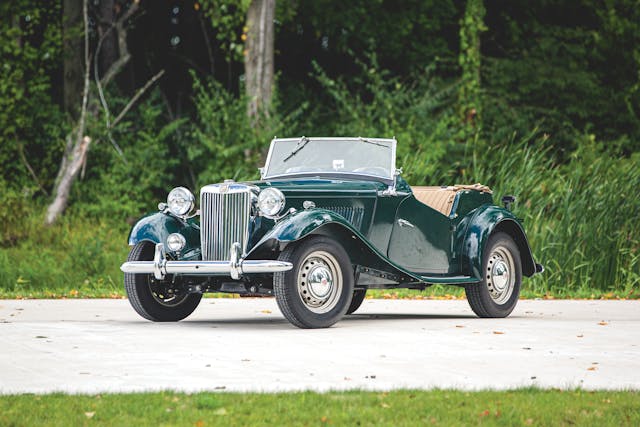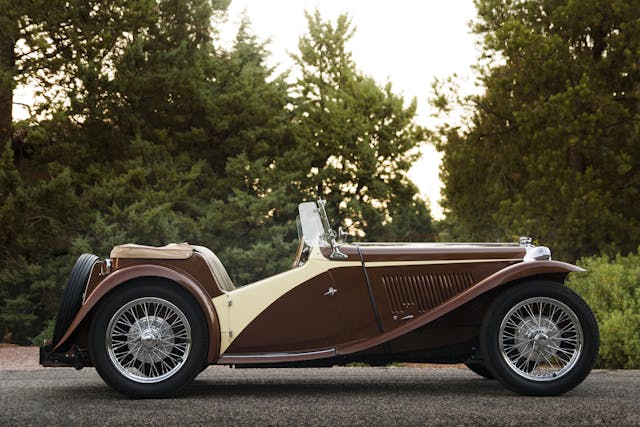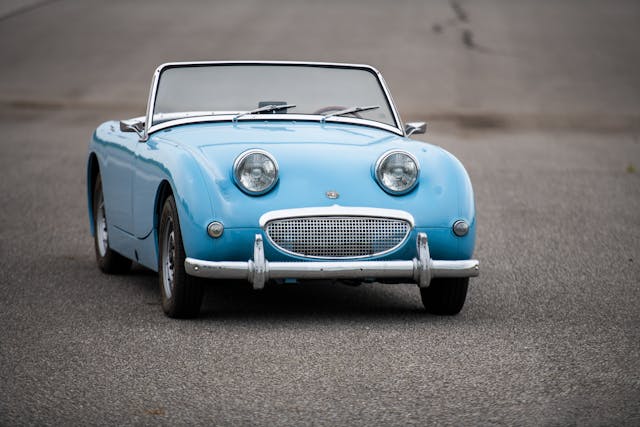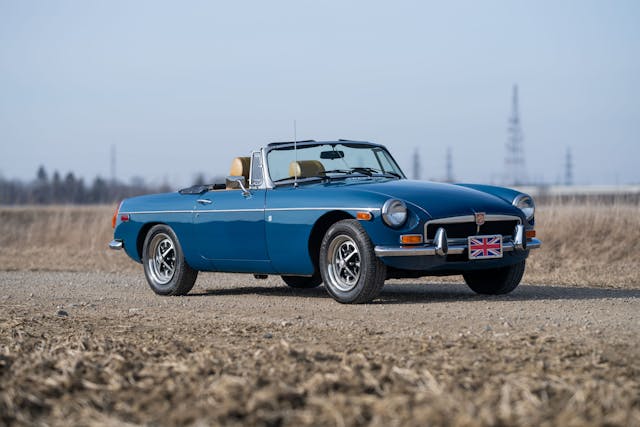These 5 British roadsters are holding their value—or better
With all that’s going on in the collector market these days, good-old-fashioned British sports cars are often overlooked. Mainstream models from MG, Triumph, and Austin-Healey offer that rare mix of gorgeous-yet-unpretentious styling and a fun-focused, minimalist mindset that’s missing from most cars built since 1980. They’re also highly rewarding choices for any enthusiast who cares less about the 0-to-60 time than how a car makes them feel. Sure, you might need to get your hands dirty a little more often, but that’s part of the appeal.
British sports cars are a huge part of the collector car market and have been since before many of the folks writing here picked up a keyboard. There’s a reason, though, that we don’t devote many headlines to old English roadsters: Insider reports on market trends, and this corner of the market hasn’t seen dramatic change. “Stable” and “quiet” describe most British car values relative to the frenzy among other sub-$50K collector cars, and Hagerty’s British Car Index is traditionally among the steadiest of the seven indices we track. But with everything from Mustang IIs to Mondials getting far pricier over the past 24 months, even some British car prices have awakened from their slumber. With that, we figured it was a good time to check in on five of the most popular British classics.
1946–55 MG T-Series

Just after World War II, American servicemen stationed in Britain hopped into the T-Series, and a love affair for the ages was born. Many had the little MG imported to the U.S. on their return home or bought one at a Stateside dealer when they became available in 1947. Their new love was a cheap date, too—the T-Series could be bought for a little more than half as much as that other landmark postwar sports car, Jaguar’s XK120.
Largely a carryover from the prewar TA and TB, the 1946–50 TC was far from cutting edge, but it was still a revelation for a nation unaccustomed to tiny, nimble, minimalist roadsters. It helped spawn the sports car market in the U.S. and launched countless racing careers—Carroll Shelby himself won his first race in a TC.
An updated TD arrived in 1950 with improved handling, better ride, wider wheels, and somewhat frumpier styling. With nearly 30,000 built, TDs are also more common than the other two models combined. The final T-Series, the TF, got fared-in headlamps, a different interior grille, more interior room, and in 1954 an available 1466cc (up from 1250) engine that brought performance up to a thumping 63 hp.
When it comes to values, the T-Series is pretty straightforward. Historically, it has been the picture of stability, with cars changing hands at moderate prices and a steady pace almost regardless of what happens in the rest of the market. There is, however, a hierarchy in the T-Series family.

The TC is the most crude and the least practical (they're all right-hand drive), but it's the purest and the original, so it's worth the most:$43,700 in #2 (Excellent, or like-new) condition. The TD is by far the most common and considered the least attractive, so this middle child is worth the least at $27,800. The TF is the fastest, most developed and arguably the best-looking, plus it's the last MG with the traditional prewar styling laid over an ash frame. TFs carry a #2 value of $36,500, while TF 1500s are worth $40,300.
By modern standards, these cars are almost more akin to carriage than car. They're not comfortable, they'll struggle to keep up with modern traffic, and they don't stop well. But they are fun, not to mention simple, rugged, and easy to live with and work on. Since they're all rather similar to own and similarly charming to look at, the TD is arguably the best value.
1955–62 Triumph TR3

Between cheap and cheerful MGs and more luxurious, expensive Jags slotted Triumph's attractive yet affordable sports cars. On American shores, the TR3 was Triumph's first sales success. Although the TR3's 1991cc overhead valve four is famously descended from an old Ferguson tractor, as a genuine 100-mph roadster and the first British production car with front disc brakes, it was a very popular road and rally racer in period. It feels a lot faster than it is, due in large part to its smooth torque delivery and dramatic, down-cut doors that expose its occupants to Mother Nature.
The first major update for the TR3 came in 1957 with the TR3A (never officially referred to as such by the factory), which added a wider and more prominent grille and such lavish equipment as door handles and a locking trunk. In order to placate U.S. dealers who feared people wouldn't like the new TR4 (spoiler: they did), Triumph introduced the TR3B (again, never officially referred to as such) in 1961 with a larger 2138cc, 105-hp engine.
TR3 prices peaked in 2013 and slowly decreased till last year, when they experienced a minor bump. Nevertheless, their median #2 value is down 15 percent over the past decade. The spread between TR3, TR3A and TR3B is small but significant with TR3s currently at $18,700, TR3As at $19,500, and TR3Bs at $22,500. Add $1000 or more for a factory hardtop.
With its swoops and flourishes, nothing looks quite like a TR3, especially for the money. Fortunately for enthusiasts, few signs point to them getting any more expensive: values have been quiet relative to other classic roadsters, and they aren't attracting new young buyers. Baby boomers and older account for 72 percent of insurance quotes for TR3s, even though those buyers make up just 41 percent of the market as a whole. Longer term, they'll likely remain a great value.
1969–76 Triumph TR6

The TR6 wasn't the last Triumph. That sad honor goes to the 1981 Acclaim, which was essentially a rebadged Honda. Nor was it the last Triumph sports car, as it was phased out in favor of the wedgey TR7 and TR8, aka "the shape of things to come." However, with its supple curves, body-on-frame construction, a throaty long-stroke engine, and minimal luxury inside, the TR6 was the last of the old-school Triumph roadsters.
Indeed, the TR6 was something of a dinosaur from the start. Introduced just in time for the Datsun 240Z to make "traditional" sports cars seem obsolete, the TR6's narrow cockpit, bouncy ride and rather crude independent suspension represented little change from the old TR4.
On the other side of the pond, the TR6's 2.5-liter pushrod six made a punchy 150 hp with Lucas mechanical injection, while twin Stromberg carbs stifled U.S.-spec cars to about 100 hp. For 1974, the TR6's chrome bumpers gained weight and sprouted large rubber overriders for U.S. safety regulations, further diminishing performance. Despite that, the engine's eager nature and satisfying exhaust note made it a back road joy. In a review on Top Gear, James May called the TR6 the "blokiest bloke's car ever built," and Paul Newman clinched his first SCCA National Championship in 1976 at the wheel of a silver and black TR6.
Triumph built over 90,000 TR6s, with the vast majority of them finding homes in America. Rust has claimed many, but TR6s remain easy to find in any condition and parts availability is generally quite good.
Unlike many other open-top Brits, TR6 prices haven't been sleepy at all. Not long ago, these were sub-$20,000 cars all day, but they started appreciating in the late 2010s. Median #2 value is up 50 percent over the last decade, to $34,300. The gap between great cars and average ones has widened considerably, though, and driver-quality TR6s can still be found in the mid-teens. The difference in price between early slim-bumper cars and later ones is minimal, but later ones came in louder '70s colors like Java Green or Magenta, if that's your thing. Desirable options include a luggage rack, overdrive, factory hardtop, and wire wheels.
Fifty years on, everything from the '70s looks old-fashioned. The 240Z may have outclassed the TR6 in period, but the Triumph's anachronisms don't stick out as much through the lens of time. Besides, with a straight-six and wood dash before you, the TR6 provides a Big Healey British experience at a significantly lower price.
1958–69 Austin-Healey Sprite

By the late 1950s, the Brits sold as many two-seaters to sports car-hungry Americans as they could screw together. But Donald Healey saw an opening at the market's entry point: young gearheads with sports car dreams who couldn't quite swing a Porsche or an Austin-Healey 100 didn't have many choices. The Sprite was Healey's answer, and for $1795 it bought you no windows, no outside door handles, no trunk lid, all-drum brakes, and 43 buzzing horsepower from BMC's 948cc A-Series four.
The headlights, which Healey planned on being retractable, were left in the fixed up position in order to save costs, and that awkward but adorable choice earned it the nickname "Bugeye" (or "Frogeye" back home in the U.K.). It wasn't just about looks, though: with precise handling thanks to its low weight and unibody construction, amateur racers across the country filled race grids with the little Sprite.
After 1961 and nearly 49,000 Mk I Sprites sold, Austin-Healey updated the model to a more conventional shape and fitted more powerful engines until discontinuing the Sprite after 1969. The nearly identical MG Midget soldiered on another decade until 1979. There's no beating the original, though. It's impossible not to be charmed by the Bugeye's smiley-faced grille and big, cartoon-eye headlights.
Cute counts for a lot in the world of little sports cars. With a #2 value of $28,000, a Bugeye is worth about twice as much as a later "square-body" Sprite. It's even pricier than the larger, more powerful MGB.
Like many other mainstream British roadsters, Sprite values have seen more growth over the past two years than they ever have before, but appreciation has been more pronounced for Bugeyes. Upgrades like disc brake conversions, later 1275-cc engines and five-speed swaps (often from a Miata) are common, but have little effect on value. Bugeyes were dirt cheap for decades and often modified, so factory originality isn't necessarily expected. What's more important is overall condition and quality of work performed.
1962–80 MGB

Until the Miata came along in 1989, the MGB was the de facto cheap roadster. While the Miata may have perfected the British formula and is itself now a classic, the MGB is still the go-to collector roadster. MG built 512,243 examples, and by count of cars insured with Hagerty, the MGB holds the titles of second-most popular sports car (after the Corvette) and second-most popular import (after the VW Beetle).
Launched at the 1962 Earls Court Motor Show with modern monocoque construction, the MGB carried on with incremental revisions till the closure of the Abingdon plant in 1980. In 1964, the 1978cc B-Series engine gained a five-main-bearing crankshaft, and after 1965 cars switched the "pull handle" for the doors to a push-button. The MGB GT arrived in 1966 with a rear roofline by Pininfarina, and although it's technically a 2+2, you wouldn't want to ride back there unless you were a piece of luggage. The 1967 MGB revised the interior trim and seats, the 1968 cars got a padded dash board, and headrests came in 1969. The 1970 MGB got a recessed black grille, rubber tips on the chrome bumper overriders, and Rostyle wheels. The biggest change, though, came halfway through the 1974 model year when the 'B was festooned with huge black polyurethane bumpers. A raised ride height messed with handling, and the engine was robbed of horsepower, of which MGs had little to spare.
Like most other MGs, MGBs are a known quantity with steady prices. Over the past couple of years, though, all the activity elsewhere in the market has caught up to these British staples, and good cars have gotten pricey.
Early MGB roadsters currently carry a #2 value of $22,900, while those in #3 (Good) condition command $11,500-$12K. MGB GTs, meanwhile, are $18,200 in #2 condition and $7200–$7500 in #3 condition. Appreciation over the past five years isn't much in dollar terms, but #2 values are up about 10 percent while driver-quality cars haven't appreciated as much.
The 1970–74 cars—the last of the chrome bumper 'Bs—currently carry #2 values of $22,200 to $22,600 in roadster form and $21,300 to $21,500 in GT coupe form. This generation of MGB has, surprisingly, appreciated 42 percent since January 2020, bringing values more in line with the purer, earlier cars. Perhaps people aren't as turned off by the padded dash and other trim differences as they used to be.
The later, compromised rubber bumper MGBs, meanwhile, have been left behind. Their #2 values are down nearly 4 percent over the last five years to $15,100. The final 1980 models are worth more at $16,400, and one option to look out for is the "Limited Edition," which added special black and silver paint, alloy wheels, an air dam, and sport steering wheel. These 'Bs can command $1500 or more over a base example.



I have a 1980 rubber bumpered B that a previous restorer removed and replaced with chrome, making it look like a slightly high riding 1974 B (it wasn’t lowered). Since nobody seems to like the rubber bumpers, I wonder if this conversion enhances or detracts from the value?
For the cost of conversion, it will not have reflected the rise in value.
I have a 1978 B I have had since 1987 (when it was just a used car).
I changed the soft top 25 years ago to a mohair one. Only change I have made.
I have owned a variety of British automobiles. I love them.
The Triumph TR6 is one of my favorite British automobiles. I also the 74 Jaguars and Jensen Healy .
I have owned, driven and restored about a dozen Bs over the last 30 years. Currently have a 69 roadster, about half restored to authentic single-year, early 69 specs. And it is the most rust-free body I have ever seen. Question: is there any price premium on this one-year-only spec car?
Just purchased a 1968 MGB convertible starting to do my research changing out parts so forth and so on just curious about lifting it up off the ground just wondering if anybody had any comments I’m all new to this.
Lifting the 1968 MGB with a quick lift..
Thank you Paul
Why?
Try some 15″ wheels and larger tires then get a different gear to drive the speedo. If you want an MGB high off the ground, get a 1974 1/2 or later.